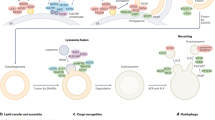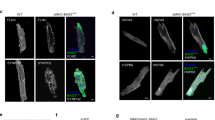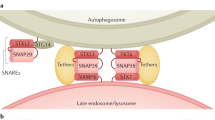Abstract
Lysosome-associated membrane protein-2 (LAMP-2) is a highly glycosylated protein and an important constituent of the lysosomal membrane1,2,3,4,5,6,7. Here we show that LAMP-2 deficiency in mice increases mortality between 20 and 40 days of age. The surviving mice are fertile and have an almost normal life span. Ultrastructurally, there is extensive accumulation of autophagic vacuoles in many tissues including liver, pancreas, spleen, kidney and skeletal and heart muscle. In hepatocytes, the autophagic degradation of long-lived proteins is severely impaired. Cardiac myocytes are ultrastructurally abnormal and heart contractility is severely reduced. These findings indicate that LAMP-2 is critical for autophagy. This theory is further substantiated by the finding that human LAMP-2 deficiency8 causing Danon's disease is associated with the accumulation of autophagic material in striated myocytes.
This is a preview of subscription content, access via your institution
Access options
Subscribe to this journal
Receive 51 print issues and online access
$199.00 per year
only $3.90 per issue
Buy this article
- Purchase on Springer Link
- Instant access to full article PDF
Prices may be subject to local taxes which are calculated during checkout




Similar content being viewed by others
References
Granger, B. L. et al. Characterisation and cloning of the lgp 110, a lysosomal glycoprotein from mouse and rat cells. J. Biol. Chem. 265, 12036–12043 (1990).
Cha, Y., Holland, S. M. & August, J. T. The cDNA sequence of mouse LAMP-2. Evidence for two classes of lysosomal membrane glycoproteins. J. Biol. Chem. 265, 5008–5013 (1990).
Konecki, D. S., Foetisch, K., Zimmer, K. P., Schlotter, M. & Lichter-Konecki, U. An alternatively spliced form of the human lysosome-associated membrane protein-2 gene is expressed in a tissue-specific manner. Biochem. Biophys. Res. Commun. 215, 757–767 (1995).
Aumüller,G., Renneberg, H. & Hasilik, A. Distribution and subcellular localisation of lysosomal-associated protein in human genital organs. Cell Tissue Res. 287 , 335–342 (1997).
Fambrough, D. M., Takeyasu, K., Lippincott-Schwartz, J. & Siegel, N. R. Structure of LEP 100, a glycoprotein that shuttles between lysosomes and the plasma membrane, deduced from the nucleotide sequence of the encoding DNA. J. Cell. Biol. 106, 61– 67 (1988).
Lewis, V. et al. Glycoproteins of the lysosomal membrane. J. Cell Biol. 100, 1839–1847 ( 1985).
Fukuda, M. Lysosomal membrane glycoproteins. J. Biol. Chem. 266 , 21327–21330 (1991).
Nishino, I. et al. Primary LAMP-2 deficiency causes X-linked vacuolar cardiomyopathy and myopathy (Danon's disease). Nature 406, 906–910 (2000).
Andrejewski, N. et al. Normal lysosomal morphology and function in Lysosomal-Associated-Membrane-Protein-Type-1 (LAMP-1) deficient mice. J. Biol. Chem. 274, 12692–12701 (1999).
Dunn, W. A. Studies on the mechanisms of autophagy: Formation of the autophagic vacuole. J. Cell Biol. 110, 1923– 1933 (1990).
Liou, W., Geuze, H. J., Geelen, M. J. & Slot, J. W. The autophagic and endocytic pathways converge at the nascent autophagic vacuoles. J. Cell Biol. 136, 61– 70 (1997).
Anderson, R. G. Postembedding detection of acidic compartments. Methods Cell Biol. 31, 463–472 ( 1989).
Arstila, A. U. & Trump, B. F. Studies on cellular autophagocytosis. The formation of autophagic vacuoles in the liver after glucagon administration. Am. J. Pathol. 53, 687–733 (1968).
Seglen, P. O. & Gordon, P. B. Amino acid control of autophagic sequestration and protein degradation in isolated rat hepatocytes. J. Cell Biol. 99, 435–444 (1984).
Henell, F., Berkenstam, A., Ahlberg, J. & Glaumann, H. Degradation of short- and long-lived proteins in perfused liver and in isolated autophagic vacuoles—lysosomes. Exp. Mol. Pathol. 46, 1–14 (1987).
Seglen, P. O. & Gordon, P. B. 3-Methyladenine: specific inhibitor of autophagic/lysosomal protein degradation in isolated rat hepatocytes. Proc. Natl Acad. Sci. USA 79, 1889– 1892 (1982).
Danon, M. J. et al. Lysosomal glycogen storage disease with normal acid maltase. Neurology 31, 51–57 (1981).
Muntoni, F. et al. Familial cardiomyopathy, mental retardation and myopathy associated with desmin-type intermediate filaments. Neuromuscul. Disord. 4, 233–241 (1994).
Morisawa, Y. et al. Lysosomal glycogen storage disease with normal acid maltase with early fatal outcome. J. Neurol. Sci. 160, 175–179 (1998).
Town, M. et al. A novel gene encoding an integral membrane protein is mutated in nephropathic cystinosis. Nature Genet. 18, 319–324 (1998).
Verheijen, F., et al. A new gene, encoding an anion transporter, is mutated in sialic acid storage diseases. Nature Genet. 23, 462–465 (1999)
Cuervo, A. M. & Dice, J. F. A receptor for the selective uptake and degradation of proteins by lysosomes. Science 273 , 501–503 (1996).
Köster, A. et al. Targeted disruption of the M(r) 46,000 mannose 6-phosphate receptor gene in mice results in misrouting of lysosomal proteins. EMBO J. 12, 5219–5223 ( 1993).
Isbrandt, D. et al. Mucopolysaccharidosis VI (Maroteaux-Lamy syndrome): six unique arylsulfatase B gene alleles causing variable disease phenotypes. Am. J. Hum. Genet. 54, 454–463 (1994).
Meredith, M. J. Rat hepatocytes prepared without collagenase: Prolonged retention of differentiated characteristics in culture. Cell Biol. Toxicol. 4, 405–425 (1988).
Janssen, P. M. L. & Hunter, W. C. Force, not sarcomere length, correlates with prolongation of isosarcometric contraction. Am. J. Physiol. 269, H676–H685 (1995 ).
Acknowledgements
We thank N. Leister, A. Wais, M. Grell, G. Jopp and D. Niemeier for technical assistance; K. Rajewski for the E-14-1 cell line; and O. Schunck and K. Nebendahl for veterinary advice. Y.T. was supported in part by the Mochida Memorial Foundation for Medical and Pharmaceutical Research and the Yamanouchi Foundation for Research on Metabolic Disorders. A.S. was supported by a fellowship of the Boehringer Ingelheim Fonds. This work was supported by the Deutsche Forschungsgemeinschaft.
Author information
Authors and Affiliations
Corresponding author
Supplementary information
Rights and permissions
About this article
Cite this article
Tanaka, Y., Guhde, G., Suter, A. et al. Accumulation of autophagic vacuoles and cardiomyopathy in LAMP-2-deficient mice. Nature 406, 902–906 (2000). https://doi.org/10.1038/35022595
Received:
Accepted:
Issue Date:
DOI: https://doi.org/10.1038/35022595
This article is cited by
-
Lysosomes as coordinators of cellular catabolism, metabolic signalling and organ physiology
Nature Reviews Molecular Cell Biology (2024)
-
Mitochondria are secreted in extracellular vesicles when lysosomal function is impaired
Nature Communications (2023)
-
Glyphosate exposure deteriorates oocyte meiotic maturation via induction of organelle dysfunctions in pigs
Journal of Animal Science and Biotechnology (2022)
-
SETD2 transcriptional control of ATG14L/S isoforms regulates autophagosome–lysosome fusion
Cell Death & Disease (2022)
-
Diesel exhaust particles induce human umbilical vein endothelial cells apoptosis by accumulation of autophagosomes and caspase-8 activation
Scientific Reports (2022)
Comments
By submitting a comment you agree to abide by our Terms and Community Guidelines. If you find something abusive or that does not comply with our terms or guidelines please flag it as inappropriate.



